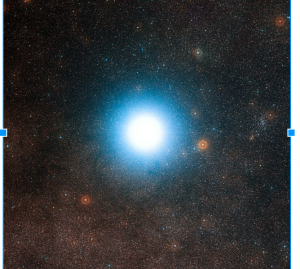Alpha Centauri from Wikipedia The two bright stars are (left) Alpha Centauri and (right) Beta Centauri. From Wikipedia
All stars have 75% hydrogen and 24% helium. The blue star is the hottest star because it’s a lot bigger and uses 17,000,000 its energy then the sun. The name of the star that iIm studying is Eta Carinae. Eta Carinae is a super giant, because it’s 8300 light years away. It’s 150 times the mass of the sun. Eta Carinae is 40,000 kelvin. That means it’s 40,000 degrees in Kelvin. Here’s the link to this site.
Like all stars, they twinkle. The blue star twinkles the brightest because it’s a really big star and it generates off more heat so that makes it twinkle more. The scientific word for twinkling stars is stellar scintillation. Stars twinkle because when we see a star twinkling, it’s really just a bunch of thick layers of air in the Earth’s atmosphere. The twinkle of the star is bent many different ways because light is curved and bent when it’s changed its density in the sky. The reason why it bends and curves is because there are pockets of cold air and hot air so that also affects it. Here’s the link I got some of the information from.
The blue stars run out of the fuel in 10,000 years. When they shine it’s super bright like 150 car headlights shining in your face. That’s really bright. Blue stars are somewhat rare. Most of the time when you look up at the sky at night there so bright that it looks like a star but it’s really just the brightness of the star. Did you know that when a scientist finds a blue star they use them to find new forming stars in space, because they’re so bright. Here’s the link to a useful site for information.

